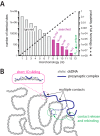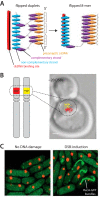DNA Sequence Alignment during Homologous Recombination
- PMID: 27129270
- PMCID: PMC4882428
- DOI: 10.1074/jbc.R116.724807
DNA Sequence Alignment during Homologous Recombination
Abstract
Homologous recombination allows for the regulated exchange of genetic information between two different DNA molecules of identical or nearly identical sequence composition, and is a major pathway for the repair of double-stranded DNA breaks. A key facet of homologous recombination is the ability of recombination proteins to perfectly align the damaged DNA with homologous sequence located elsewhere in the genome. This reaction is referred to as the homology search and is akin to the target searches conducted by many different DNA-binding proteins. Here I briefly highlight early investigations into the homology search mechanism, and then describe more recent research. Based on these studies, I summarize a model that includes a combination of intersegmental transfer, short-distance one-dimensional sliding, and length-specific microhomology recognition to efficiently align DNA sequences during the homology search. I also suggest some future directions to help further our understanding of the homology search. Where appropriate, I direct the reader to other recent reviews describing various issues related to homologous recombination.
Keywords: DNA recombination; DNA repair; Dmc1; Rad51; RecA; biochemistry; biophysics; homologous recombination; homology search; single-molecule biophysics.
© 2016 by The American Society for Biochemistry and Molecular Biology, Inc.
Figures




References
-
- San Filippo J., Sung P., and Klein H. (2008) Mechanism of eukaryotic homologous recombination. Annu. Rev. Biochem. 77, 229–257 - PubMed
-
- Cromie G. A., Connelly J. C, and Leach D. R. (2001) Recombination at double-strand breaks and DNA ends: conserved mechanisms from phage to humans. Mol. Cell 8, 1163–1174 - PubMed
-
- Cox M. M., Goodman M. F., Kreuzer K. N., Sherratt D. J., Sandler S. J., and Marians K. J. (2000) The importance of repairing stalled replication forks. Nature 404, 37–41 - PubMed
Publication types
MeSH terms
Substances
Grants and funding
LinkOut - more resources
Full Text Sources
Other Literature Sources
Research Materials

